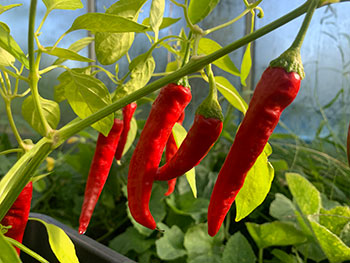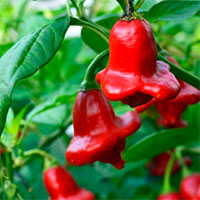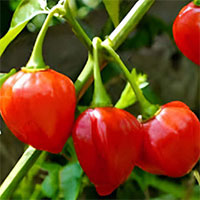 Chili peppers (Capsicum species) have their origin in the Western Hemisphere and in tropical regions of the two American continents. Chillies are botanically perennials when they grow in their natural environment and are bushy. In colder climates, they often grow as annuals. Some species, which are being kept indoors after summer, can have a good harvest in the following year.
Chili peppers (Capsicum species) have their origin in the Western Hemisphere and in tropical regions of the two American continents. Chillies are botanically perennials when they grow in their natural environment and are bushy. In colder climates, they often grow as annuals. Some species, which are being kept indoors after summer, can have a good harvest in the following year.
Chili, chilli or chile?
All three names (and even more) can be used. In Europe it's mostly spelled as chili. The correct spelling in the United States is also chili. The United Kingdom, Australia and New Zealand are talking about the chilli. Spanish-speaking countries use the word chile or Aji in South-America.
The chili plant
There is a wide variety of chilli plants, as well as in habit as in size. The average height is less than one meter. However, there are chilli plants which grow 10 meters high! Domesticated chilli plants (cultivated by people) are often self-pollinating. They don’t need other plants to set fruit. Pollination and cross-pollination (pollination of pistils of a flower with pollen from a different plant of the same species) is done by insects. In greenhouses and gardens it’s possible that pollination can occur between different types of chillies. Their successors are hybrids. To avoid this, commercial growers (who want to keep their seeds pure) cultivate chillies of the same variety at least 1.5 km from another variety. That’s more than the average bee will fly.
Chilli fruits have a large variety of shapes, colors and sizes. Unripe pods can be green, yellow, white or purple, ripe pods can be red, orange, brown, yellow, green or white. Most varieties can be harvested after 70 days in the green state, but are fully ripened after 130 days.
Botanically speaking chilli pods are berries. In horticulture they often speak about fruit. When chillies are harvested in the green state, we call it a vegetable. Ripened and dried chillies are called herbs. Are you still with us?
The species
There are over thirty different species of chillipeppers (Capsicum species). These species produce more than 10,000 varieties. Some are wild and can be found deep in the rainforest. Others are cultivated by people. In general the following five species are cultivated by people.
 Capsicum annuum
Capsicum annuum
Although annuum (Latin: yearly) should be an annual plant, this species is perennial. Capsicum annuum is the most widely cultivated chilli in the world, both commercial and private. Because this species crosses so easily, there are thousands of different varieties. The Jalapeño is also one of them. .
 Capsicum baccatum
Capsicum baccatum
Baccatum means ‘berry-like’. But some species have very large pods. In South America, this type is the most famous and most cultivated. In this part of the world, he is also known as ‘ají’ (ah hee). The Bishops Crown is a baccatum variety.
 Capsicum chinense
Capsicum chinense
In the 18th century a Dutchman was false naming this species chinense (from China). But it’s coming from the Amazon in Brazil and not from China. It’s very popular in the tropical regions and is the most often used pepper in the Caribbean. The chillies can be extremely hot. The Habanero chocolate and the Fatalii belong to this species.
 Capsicum frutescens
Capsicum frutescens
Frutescens means bushy. These species include the African Bird’s Eye Chili and the Tabasco.
 Capsicum pubescens
Capsicum pubescens
This species is perhaps the least known. Pubescens means hairy. The leaves of this species are hairy.
